| |
10:00
|
0607.
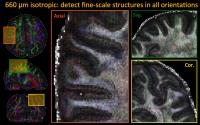 |
Generalized SLIce Dithered Enhanced Resolution Simultaneous
MultiSlice (gSlider-SMS) to increase volume encoding, SNR and
partition profile fidelity in high-resolution diffusion imaging. 
Kawin Setsompop1, Jason Stockmann1,
Qiuyun Fan1, Thomas Witzel1, and
Lawrence L. Wald1
1A.A. Martinos Center for Biomedical Imaging,
charlestown, MA, United States
In this work, we propose generalized Slider (gSlider) method
which utilizes RF encoding to markedly improve the ability
of slice super-resolution in acquiring a large number of
imaging slices simultaneously in diffusion imaging, to
increase volume encoding and SNR. In particular, we show
that gSlider can be use to acquire 5 slices simultaneously
to provide close to the theoretical √5 SNR gain, while
retaining sharp slice/partition resolution, comparable to
that of conventional 2-D slice-selective imaging. Through a
combined gSlider-SMS acquisition (5x-gSlider and MB-2), we
demonstrate a highly efficient 10 simultaneous slice
acquisition for high quality whole-brain 660μm isotropic
diffusion imaging.
|
| |
10:12
|
0608.
 |
Online Radial Multiband Magnetic Resonance Fingerprinting 
Martijn A Cloos1,2, Tiejun Zhao3,
Florian Knoll1,2, and Daniel K Sodickson1,2
1Bernard and Irene Schwartz Center for Biomedical
Imaging, New York University School of Medicine, New York,
NY, United States, 2Center
for Advanced Imaging Innovation and Research (CAI2R), New
York University School of Medicine, New York, NY, United
States, 3Siemens
Medical Solutions USA Inc., Malvern, PA, United States
Magnetic resonance fingerprinting (MRF) is a promising new
approach for rapid quantitative imaging. So far, multi-slice
acceleration (MSA) for MRF has been based on a gradient
t-Blipped multi-slice scheme. However, for traditional MR
sequences using thick slices, it has been shown that
radiofrequency based phase encoding works better than the
gradient blipped implementation. In this work we demonstrate
an RF based MSA approach for radial sampled MRF experiments
such as PnP-PTX including a fully integrated online image
reconstruction pipeline that creates both quantitative maps
(T1, T2, PD and B1+) and synthesized
contras weighted images (MP-RAGE, T1-TSE and T2-TSE).
|
| |
10:24
 |
0609.
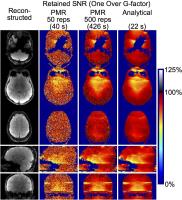 |
Analytical G-factor for Cartesian Simultaneous Multi-Slice
Imaging 
Kangrong Zhu1, Hua Wu2, Robert F.
Dougherty2, Matthew J. Middione3, John
M. Pauly1, and Adam B. Kerr1
1Electrical Engineering, Stanford University,
Stanford, CA, United States, 2Center
for Cognitive and Neurobiological Imaging, Stanford
University, Stanford, CA, United States, 3Applied
Sciences Laboratory West, GE Healthcare, Menlo Park, CA,
United States
In simultaneous multi-slice (SMS) imaging, a commonly used
method to compute the g-factor is the pseudo multiple
replica method, whose accuracy depends on the number of
simulated replicas. In this work, we derive analytical
g-factor maps for SMS acquisitions with arbitrary Cartesian
undersampling patterns basing on a hybrid-space SENSE
reconstruction. Brain images demonstrate that the analytical
g-factor maps agree with those calculated by the pseudo
multiple replica method, but require less computation time
for high quality maps. The analytical maps enable a fair
comparison between coherent and incoherent Cartesian SMS
undersampling patterns.
|
| |
10:36
 |
0610.
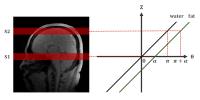 |
Correction of Chemical-Shift Ghost Artifact in Blipped
Controlled Aliasing Parallel Imaging 
JaeJin Cho1, Dongchan Kim1, Hyunseok
Seo1, Kinam Kwon1, Seohee So1,
and HyunWook Park1
1Korea Advanced Institute of Science and
Technology (KAIST), Daejeon, Korea, Republic of
Blipped-CAIPI imaging is widely used for fast imaging, which
is one of the simultaneous multi-slice imaging methods.
Conventional water-fat separation methods can be combined
with the blipped-CAIPI technique. However, it results in the
chemical-shift ghost artifact because fat signal on slightly
shifted position is exited in the slice-selection process.
This geometric error in slice-selection generates additional
phase cycling, which causes the ghost artifacts on each
slice’s fat image. In this abstract, a SENSE-based water-fat
separation method is proposed, which considers the
additional phase cycling on fat signal and obtains more
accurate water-fat separated images.
|
| |
10:48
|
0611.
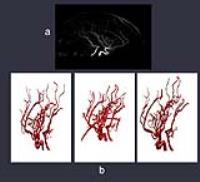 |
Simultaneous Multislice AcquisitioN G-noise reduction &
Reshifted CAIPI In Angiography (SANGRIA) - Permission Withheld
Zahra Fazal1, Jennifer Schulz1, Jose P
Marques1, and David G Norris 1,2
1Donders Center for Cognitive Neuroimaging,
Radboud university, Nijmegen, Netherlands, 2Erwin
L.Hahn institute for Magnetic Resonance Imaging, Essen,
Germany
To reconstruct blood vessel in 2D and 3D MB TOF MRA without
using coil sensitivity profile to reduce g-factor noise. The
idea is to use CAIPRINHA on sparse angiographic data that
first shift each slice/slab differently and then apply CAIPI
reshift to shift each slab to its original position to form
a continuous vessel tree. Results showed that the vessel
reconstruction in 2D and 3D MB is comparable to standard
single band MS TOF. Vessel reconstruction in MB angiography
without using coil sensitivity profile can lead to high MB
factors reducing the aquistion time and high sensitivity in
detecting small vessels
|
| |
11:00
 |
0612.
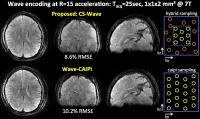 |
Optimized CS-Wave imaging with tailored sampling and efficient
reconstruction 
Berkin Bilgic1, Huihui Ye1, Lawrence L
Wald1, and Kawin Setsompop1
1Martinos Center for Biomedical Imaging,
Charlestown, MA, United States
Wave-CAIPI utilizes additional gradients during the readout
to improve controlled aliasing and fully harness coil
sensitivity encoding. Recently proposed CS-Wave extended
Wave-encoding with Poisson sampling and wavelet
regularization. This work proposes optimized CS-Wave with i)
tailored data-sampling and ii) highly efficient
reconstruction. At 15-fold acceleration, proposed CS-Wave
provides 20% RMSE improvement over Wave-CAIPI, which nearly
doubles the improvement achieved with previously proposed
CS-Wave. This permits single head-orientation Quantitative
Susceptibility Mapping at 1×1×2mm3resolution in
25s. Combining CS-Wave with SMS Echo-Shift strategy further
increases the acceleration to 30-fold, thus enabling
multi-orientation QSM at long-TE from three head-rotations
at 1.5mm isotropic in 72s.
|
| |
11:12
|
0613.
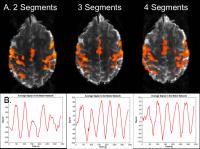 |
Multiband and Multishot EPI Using Hadamard Encoding for
Functional MRI at 7T 
Alexander D. Cohen1, Andrew S. Nencka1,2,
and Yang Wang1,2
1Radiology, Medical College of Wisconsin,
Milwaukee, WI, United States, 2Biophysics,
Medical College of Wisconsin, Milwaukee, WI, United States
In this study a novel technique was tested combining
multiband and multishot imaging for functional MRI at 7T.
Hadamard and segmented multi-shot encoding were applied to
yield short TR, reduced distortion fMRI images without the
need for parallel imaging reconstruction techniques.
Furthermore, acquiring segmented data allows for datasets to
be reconstructed with effective in-plane accelerations up to
the number of segments. Thus, one can reconstruct a dataset
with higher SNR and the reduced geometric distortion of a
highly accelerated acquisition.
|
| |
11:24
 |
0614.
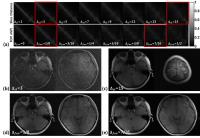 |
SMS-HSL: Simultaneous Multi-Slice Aliasing Separation Exploiting
Hankel Subspace Learning 
Suhyung Park1 and
Jaeseok Park2
1Center for Neuroscience Imaging Research,
Institute for Basic Science (IBS), Suwon, Korea, Republic
of, 2Department
of Biomedical Engineering, Sungkyunkwan University, Suwon,
Korea, Republic of
Simultaneous multi-slice (SMS) acquisition has recently
gained attention in clinical and research applications.
However, since the spatial variation of coil sensitivity
along the slice direction is typically insufficient and thus
SMS reconstruction including SENSE/GRAPPA and slice-GRAPPA
is potentially ill-conditioned, it is challenging to
separate the aliased slices in the presence of noise with
increasing multi-band factors (MB). In this work, we propose
a novel, SMS reconstruction method that exploits Hankel
subspace learning (SMS-HSL) for aliasing separation in the
slice direction, in which SMS signals are projected onto an
individual subspace specific to each slice by incorporating
the proposed SMS model into a constrained optimization with
low rank and magnitude priors. Simulation and experiments
were performed at high MB factors to demonstrate the
effectiveness of the proposed SMS-HSL over conventional SMS
methods.
|
| |
11:36
|
0615.
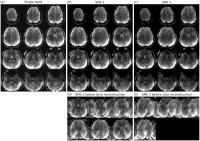 |
High resolution simultaneous multi-slice GRE at 9.4T using
16-channel SMS-pTX spokes excitations for slice-by-slice
flip-angle homogenisation 
Desmond H Y Tse1, Christopher J Wiggins2,
and Benedikt A Poser1
1Faculty of Psychology and Neuroscience,
Maastricht University, Maastricht, Netherlands, 2Scannexus,
Maastricht, Netherlands
RF inhomogeneity at ultra-high field MRI leads to unwanted
variations in image contrast and SNR. RF homogenisation at
9.4T was achieved with parallel transmission (pTx) of
slice-specific spokes pulses designed offline using acquired
B0 and B1+ maps. These spokes pulses were combined
on-the-fly on the scanner to form simultaneous multi-slice
(SMS) excitations, with optimised inter-slice phases to
minimise the SMS pulse amplitude. The pTx spokes SMS pulse
allowed a time efficient high resolution 2D GRE T2*-weighted
imaging at 9.4T with whole brain coverage and minimal
artefacts caused by RF inhomogeneity.
|
| |
11:48
 |
0616.
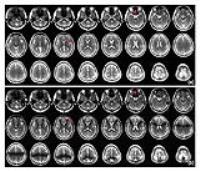 |
Phase-cycled simultaneous multi-slice balanced SSFP imaging with
CAIPIRINHA for efficient banding reduction 
Yi Wang1, Xingfeng Shao1, Thomas
Martin1, Steen Moeller2, Essa Yacoub2,
and Danny JJ Wang1
1Neurology, UCLA, Los Angeles, CA, United States, 2Center
of Magnetic Resonance Research, University of Minnesota,
Minneapolis, MN, United States
The application of balanced SSFP (bSSFP) is limited by the
banding artifact resulting from its sensitivity to field
inhomogeneity. A common approach for band reduction
involves multiple measurements with different RF phase
cycling, at the cost of lengthened total imaging time. In
this work, we present a novel time-efficient bSSFP banding
reduction technique by utilizing simultaneous multi-slice
(SMS) imaging with CAIPIRINHA to acquire multiple
phase-cycled images within the same imaging time of a
single-band bSSFP scan. Effective band reduction is
demonstrated in phantom, abdominal and brain imaging with
SMS factor up to four.
|
|












